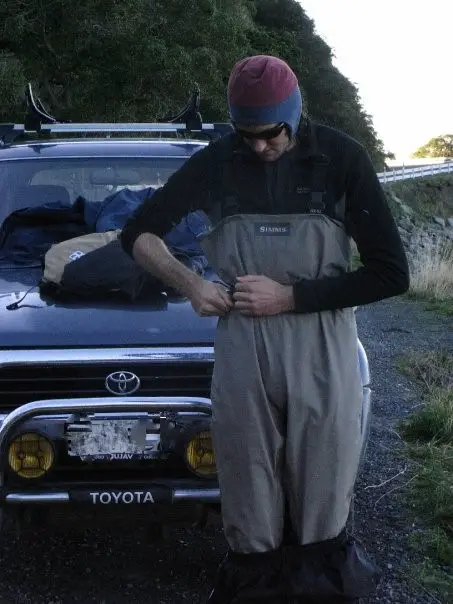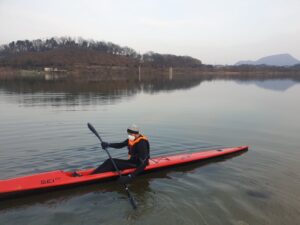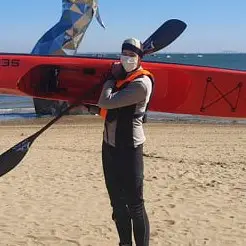At this time of year, I often hear new kayak fishermen ask what to wear when winter fishing. In this guide, I provide an overview of the different options, and situations where I feel they are best suited.
There is a wide selection of different paddling clothing available, and over the years I have worn most combinations. I will start by saying, not one piece or style of clothing is the best but they are all bring a set of compromises to the table.
Can you kayak fish over winter?
Yes, as long as the water is liquid it is possible to Kayak fish, but because of the cold conditions extra precautions need to be taken. It is important to dress warm, and to stay dry. When deciding what to wear, it is crucial that it also keeps you warm to wet. That it provides protection if you end up in the water.
As a general rule, if the temperature is below freezing (32f), then I stay off the water. I do not cross shore ice to launch. If I have to cross surface ice, I stay home. When temperatures are below freezing it is too miserable, and at these temperatures ice can start forming on the kayak and even fishing equipment. I also take wind chill into consideration, a few knots of wind can make a cold day on the water all but unbearable. Wind simply cuts through wet clothing and sucks any body heat away.
I also plan my fishing, to require as few knots as possible. I do not want to take my gloves off to tie knots. So I usually tie on a snaplock swivel which makes changing lures much simpler.
This is partly personal preference, but when it is very cold. I do prefer to troll than to float and cast. By paddling constantly, it helps maintain my body temperature so i feel warmer for longer. If I do start to cool down, I can always put on a burst of speed to try and get the blood flowing again.
How to keep head, face, hands and feet warm?
I find it is quite easy to keep my body warm while kayak fishing over winter. What really starts to burn are the extremities.
Head. On my head I like to wear a snug fitting fleece or wool hat. I make sure it goes down far enough to cover my ears. Colds ears can really start to hurt after a while.
Face. I find it hard to cover my face entirely while paddling, I have tried wearing a balaclava and various ski masks.. but they are always uncomfortable and trend to become wet from breath moisture. I prefer not to wear them. I have discovered, that medical masks do a good job warming the air which can actually feel pleasant in very cold weather.
Hands. I hate wearing anything on my hands while kayaking, but that means numb and painful fingers over winter. When temperatures get cold enough, I wear a thick neoprene glove. I like the glacier gloves.
Feet. I wear 5mm neoprene booties. They do a good job keeping my feet warm. I wear the soft sole variation because my feet are large and will not fit when I wear a hard sole boot. But, hard soles work just as well and are even more durable when launching.
Are waders good for kayak fishing?

Waders are a great choice for staying dry when kayak fishing. I have worn them for year. I like waders due to their ease of use. I drive to the launch spot, throw my waders on overtop of my base layers and I am waterproof up to chest height.
Some people are concerned that waders are not safe, but if you capsize while wearing waders typically the water pressure pushes out all of the air and they become ‘shrink-wrapped’ next to the skin. Water only slow sips in. In saying that, I only wear waders in situations where I know the chance of capsizing is extremely low.
When wearing breathable waders, it is essential to wear a life jacket or PFD. With a life jacket, you are never going to sink.
In very cold winter conditions, neoprene waders are both warmer, and more durable than their breathable counterparts.
I also like to combine waders with a dry suit paddling jacket. This does an excellent job of keeping me completely dry.
I personally feel waders are at their best when the water is much colder than the air. Waders keep the legs and lower body perfectly dry while allowing the upper body to breathe and regulate temperatures.
+ Easy to put on and take off. Keeps clothing worn underneath dry.
+ Keeps feet entirely dry, allowing them to stay warm.
+ Trap heat next to the body.
+ Possible to wear multiple layers underneath.
– Only provides protection up to chest height. Need to be worn with a jacket or additional clothing on top.
– Waders need to be clean and dried after use, fish slime and sweat can quickly damage waders.
– Waders should be worn with a wading belt or two to trap air in, and to keep water out encase of a swim.
Should I wear a wetsuit when kayak fishing?

If you are on a budget, a wetsuit is the way to go, and I find them warm enough in temperatures down freezing. Although, on very chilly days I sometimes wear clothing overtop for additional insulation.
When paddling over the coldest winter months, my clothing of choice is a wetsuit. I wear a full, single piece 5mm wetsuit. I suffer from cold arms, and legs, so I need all the warmth I can get on my extremities.
Wetsuits vary greatly in price. I have worn both cheap, budget wetsuits like my current one. To high end, custom made suits. They all keep me warm and to be honest, I do not notice much difference between them. Although the expensive neoprene does tend to be a bit more stretchy, the seams are slightly better finished.
I know that many kayakers suggest wearing a 2/3mm or a 3/5mm or even a farmer john style wetsuit. These designs have thicker material on the body, and thinner on the arms and legs. These wetsuits are popular because the thinner neoprene on the arms is more flexible, allows for more movement. Well, I don,t believe it matters. I can paddle just fine wearing full thickness neoprene, and warm arms are more important than better flexibility.
Farmer john style wetsuits, or the ones with variable thicknesses are find in the warmer months, but I find when winter kayaking I need every piece of warmth I can get.
I even take my racing kayaks out while wearing a full 5mm suit, and my average speed is still respectable. I paddle just fine and my technique does not suffer. My times are ever so slightly slower, but that is probably more down to the extremely cold conditions rather than the thickness of my suit. And, to be honest, I am not racing, it does not matter that it will take me an extra 30 seconds to reach my destination. When paddling in the winter, wear a warm wetsuit, not one which maximizes movement.
Wetsuits, are also excellent in the water. That is what they are design for. I can spend an hour snorkelling in 45 degrees water while wearing a 5mm wetsuit, so a two minute swim after a capsize, even in colder conditions is not going to matter. Wetsuits work but trapping a warm layer of water next to the skin. So they work equally as well both on or under the water.
So far, I mostly wrote about the positives. How about the negatives? The biggest negative is that they are difficult to put on and take off. Even more so if you need to change while standing on frozen ground. I get around that by putting my wetsuit on at home, then taking it off at home. It is simply too cold to change out of a wetsuit outside during the winter.
Wetsuits, also do not feature integrated socks or booties. So you must wear them with some neoprene socks. Most neoprene socks are 3mm, but for winter paddling I suggest getting 5mm for extra warmth.
+ Traps heat next to the body.
+ Most affordable option
+ Full body warmth, excluding head, hands, and arms.
+ Good durability and easy to clean
+ Has very good buoyancy
– Does not breathe.
– Must be naked underneath.
– extremely cold to change into or out of wetsuit in the parking lot.
– Less suitable for extremely cold conditions
Should I wear a drysuit when kayak fishing?
Drysuits, like the name suggests, are designed to keep the wearer completely dry. You wear them over the top of your other paddling clothing.
Drysuits, probably represent the best compromise between warmth, dryness and comfort. They are very popular among sea kayakers, especially once the water temperatures have start to drop.
But, they do come with a few serious downsides which is why I do not recommend them for kayak fishing.
Firstly, there is no escaping the face that drysuits are expensive. Even the cheapest versions typically cost several hundred dollars, and the good quality ones cost over a thousand.
Drysuits also share many of the downsides as waders, in that to prolong their life they must be kept clean and dry. Nothing damages a drysuit fabric quicker than fish slime and blood. This applies to all paddling clothing, but it is important, after cleaning to make sure that your drysuit is dry inside and out. Otherwise mold can start to grow.
Another downside of drysuits is that they are basically only a waterproof and windproof layer. They provide little warmth by themselves, and that warmth depends on them remaining watertight. A cut, or hole in a drysuit have proven to be fatal for people in the water. A cut in a wetsuit is much less serious than a cut in a wetsuit, or even waders.
The one situation, where I will consider wearing a drysuit is in extremely cold conditions, where the neoprene of a wetsuit is not quite enough to keep you warm. The colder it gets, the more layers you can wear beneath a drysuit to keep you warm.
+ Waterproof shell which is designed to keep all water out
+ Can wear multiple layers to match the temperatures
+ Easy to change into, and out of outside without freezing.
– Not the most durable, a cut can be fatal.
-Fish slime and blood can damage the fabric
– Are usually expensive.
Fleece Line Neoprene Paddling clothing and winter fishing.

When water temperatures are a bit warmer. Somewhere around 50f (10c), I prefer to wear a fleece line neoprene paddling clothing. But I do have rock solid stability and can remount in an instant. Believe me, 50f water is cold, and fleece line neoprene is not designed to be worn in the water for a long amount of time. If you are not 100% confident about remounting, I suggest wearing a wetsuit instead which will provide a lot more warmth.
Like the name suggests, fleece line neoprene it is a very thin layer of neoprene (normally 1-1.5mm) with a fleece lining. They provide good warmth and are very easy to wear.
On average, I can get two years out of fleece line paddling clothing. The first year, when new I wear in colder conditions. Then the following year, I wear more in the shoulder season.
Fleece line neoprene, is not suitable for very cold winter days, although they can still be used as a layering option for additional warmth.
If you do capsize while wearing fleece line neoprene. It is important to get back onto the boat as quickly as possible and start paddling. They do not provide much protection against the cold.
